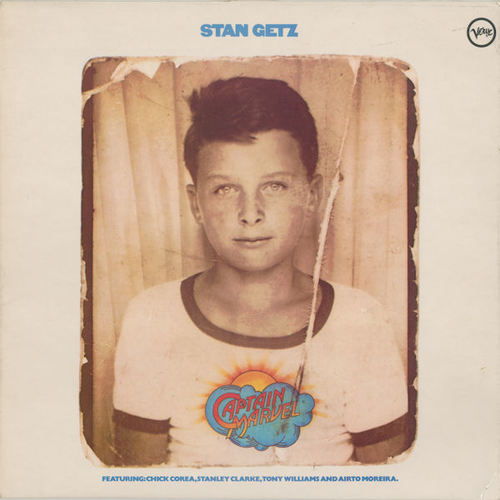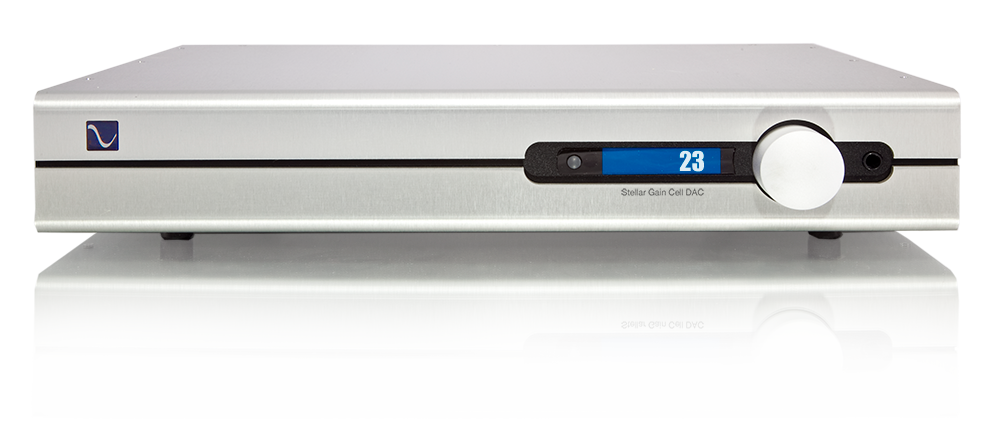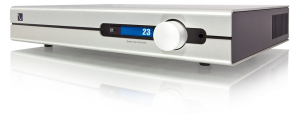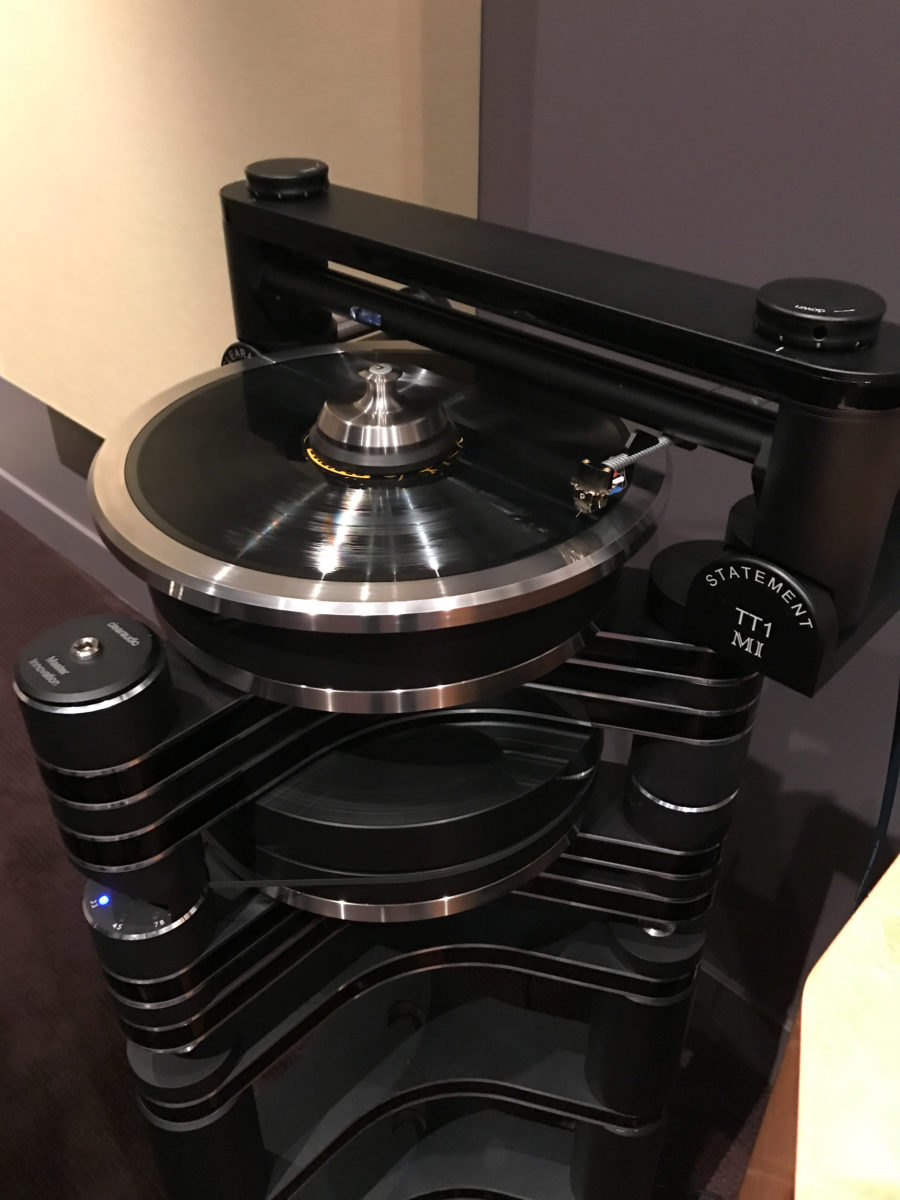Price
$1,699. Available direct from PS Audio (USA customers only), or via your local dealer.
Description
New DAC/Preamp from PS Audio. Notable for DSD128 via USB, all analog gain and volume control, input switching among multiple analog and digital inputs.
Background
I’m a big fan of DACs from PS Audio. I’ve had three in my system for extended listening: The Digital Link III ($995), it’s predecessor, the NuWave DAC ($995), and now this DAC/preamp combination, the Stellar Gain Cell DAC ($1,699). All three are well-built, flexible, capable units, and all three have balanced XLR outputs. I run long balanced cables from my front end to my powered speakers, so the balanced outputs are a must-have.
The Stellar DAC/Preamp is, of course, different from the DLIII and NuWave in that it has preamp functionality in addition to being a DAC. As PS Audio describes it:
There isn’t a DAC made that doesn’t benefit from a great analog preamplifier. The Stellar Gain Cell DAC combines the benefits of both—a full-featured DAC with an exceptional analog preamplifier controlling its output level.
For me, having a quality analog volume control on the DAC, as well as switching for multiple analog inputs, is a huge win. But the fun doesn’t stop there. Check out the list of goodies packed into this little wonder:
Features & Specs (from PS Audio website)
- Class A balanced analog preamplifier
- Full function DAC
- Class A headphone output
- Remote control
- Fixed or variable DAC mode
- 2 output 12 volt triggers
Analog preamplifier:
- One balanced analog input
- Three single ended analog inputs
- Analog Gain Cell stage
- Fully balanced input to output
- Balanced XLR analog output
- Single ended RCA analog output
- Home theater bypass
- Direct coupled without any capacitors in output signal path
Digital To Analog Converter:
- Four digital inputs
- I2S input
- Digital Lens technology
- Three user selectable digital filters
- Compatible with PS Audio DMP for SACD playback in DSD
- DSD direct through I2S
- 192kHz asynchronous coax and TOSLINK inputs
- 192kHz asynchronous USB
- Single and double rate DSD
- CPLD input (FPGA) lowers jitter, waveshapes, reduces propagation delay
- Native mode standard
- No added Sample Rate Conversion
- High current class A hybrid output stage
- Passive output filter lowers transient distortion
- Direct coupled without any capacitors in output signal path
- High bandwidth output stage -3dB 60kHz
- Low jitter clocks
- High Current oversized analog power supply
- 7 voltage regulators
- High speed power supply diodes
- Massive 15,000 mFd low ESR capacitors
- ESS Hyperstream

Operation
I tried out nearly all the functions of the Stellar Gain Cell DAC during the course of my three week evaluation, and I never ran into any real glitches. Front panel controls, back panel connections and remote were all straightforward and generally a pleasure to use. There are a couple things I would change, however, given the chance.
My main complaint has to do with the display. Or, more accurately, what is and isn’t shown on the display at any given time. Ideally, I’d like the display to show the following, anytime it is on during normal operation:
- Volume level
- Selected input
And for digital inputs, I’d like to see these two as well:
- Filter, since it can be changed directly on the remote, and might be changed accidentally.
- Phase (if reversed). It too can be changed on the remote.
PS Audio gets it almost right. They include all of the above on the display except the selected input (unless in DAC only mode, in which case volume isn’t a thing, and the display works perfectly). When the preamp is active, you have to push the little menu selector button on the front panel to see the currently selected input. There isn’t a way to see the selected input using the remote unless you press one of the input buttons, at which point that input becomes the selected input and is briefly shown on the display.
Also, the display turns off automatically, presumably to save energy or perhaps prevent burn-in (?). Exactly when it turns off is determined by the “Display Time” setting in the options menu. According to the manual:
This is the amount of time the Display is on. Rotating the volume knob selects times from 10 seconds to 1 hour. Auto will turn off the display if no signal is detected.
So, here’s where it gets weird. There is also a “Dim” button on the remote, and instead of dimming the display as one might expect, this button actually turns off the display. However, it will not turn off the display if the Display Time setting is set to “auto” and a signal is present. It tries, but the display stays on since a signal is immediately detected (otherwise the display would not have been on in the first place!).
Things get even nuttier if Display Time is set to “auto” and you play music that has very quiet sections using an analog input. Depending on the level of signal present, the display turns off during the quiet sections and comes back on during the loud ones! Between this quirk and the “dim” button behavior, it took me several evenings of investigation before I finally figured out that was happening…
ANYWAY, I would have preferred no “Display Time” setting at all, and for the “Dim” button on the remote to simply cycle through bright, dim, and off settings. This way, one could affect the display brightness via the remote (instead of via the options menu only), turn off the display when desired, and allow the display to stay on regardless of signal detection. This just seems more standard and straightforward to me.
I must say, the remote is a great size. Not too big and not too small. It also has excellent range and a startlingly good operating angle–the IR sensor is much better in the Stellar than in my PS Audio GCPH phono preamp.
Oh, yeah. And I have a wish. It would be really handy to be able to set a volume offset for each input so all the inputs are roughly the same level. During my audition, switching between certain analog and digital inputs caused a big swing in output level and had me scrambling for the volume control each time.

Sound
Let me just cut to the chase. The Stellar exceeded my expectations for sound quality in nearly every respect. The digital inputs produced gobs of detail, great dynamics, proper soundstage, and excellent extension. Ripped CDs and hi-res downloads sounded astoundingly good via USB input played by my player of choice, Channel D’s Pure Music, on my Macbook Pro. Plus, the analog inputs sounded clean, full, and lively. Exactly like I hoped they would!
PS Audio uses the word “lush,” among others, to describe the Stellar’s sound. I disagree. I’d describe it as “accurate,” and dead center in the hard/soft, fast/slow, and cold/warm spectra. There is lots of fine detail, but there is also palpability. Could I use a little more meat on the bones? Sure, but now I’m wishing the Stellar designers deviated from neutral just to benefit my system (horns and solid state). Bad reviewer!
Here are some of the ways I tried to get the Stellar to show me a sonic wart or two:
- Vinyl through PS Audio GCPH phono stage via balanced analog inputs.
- SACD through Denon DVD-2900 via single ended analog inputs.
- CD through Denon DVD-2900 via single ended analog inputs.
- CD through Denon DVD-2900 via RCA COAXIAL input.
- CD through Denon DVD-2900 via TOSLINK Optical input.
- 16 bit/44.1 kHz ALAC files through Pure Music on Macbook Pro via USB input.
- 24 bit/196 kHz ALAC files through Pure Music on Macbook Pro via USB input.
- DSD64 files through Pure Music on Macbook Pro via USB input.
I also tried using my trusty PS Audio Digital Link III DAC for most the above (no DSD) via balanced analog inputs.
Each time I thought the Stallar was adding a hint of glare or grit or leanness, I’d remove it from the chain and realize it was in the recording (or the room, or the speakers, or the cables… Isn’t this hobby FUN!). IÂ kept thinking I could catch the Stellar doing something wrong, sound-wise, but it simply didn’t happen. Bravo!

Conclusion
There’s no way around it, this is one hell of a lot of value packed into a single chassis. And the sound is as good or better than you are going to get for the price–especially when you consider the Stellar is both a DAC and a preamp. It provides outstanding, modern digital conversion as well as clean analog source selection and volume control. And it does so without adding noticeable noise or veiling, and without removing detail, depth, or tone color. Aside from a couple usability quirks, its operation was flawless, and the build quality is exceptional. Highly recommended!
Equipment Used
- Signet TK7E MM cartridge
- Technics EPA-100 tonearm with Applied Fidelity rewire (copper)
- Technics SP-10MK2 turntable with obsidian base
- PS Audio GCPH phono preamp
- MacBook Pro with 2.9 GHz Intel Core i7 processor, 8 GB of memory, battery powered
- Other World Computing USB 2.0 cable (1 meter)
- Denon DVD-2900 SACD / CD player and transport
- PS Audio Digital Link III DAC
- AudioQuest VSD-1 75ohm coaxial digital cable (2 meter)
- Mogami 3173 with Neutrik NC3-B series XLR interconnects (1 meter)
- Avantgarde Acoustic SOLO active, coaxial 2-way horn speakers
- Blue Jeans Cable Belden 1800F with Neutrik NC3-B series XLR connectors (25 ft)
- No-name black power cords (1 meter)
- PS Audio UPC-200 Power Center power conditioner
Software Used
- Channel D Pure Music v3.0.6 music server software using Memory Play and volume set to 0.0 dB.
- All music files in Apple Lossless or DSD format.
- 16 bit/44.1 kHz files ripped from CD using Apple Lossless Encoder setting in iTunes with Error Correction.
- All hi-rez files downloaded in Apple Lossless format, FLAC, or DSD.
- FLAC files converted to Apple Lossless format using XLD decoder.
Music Used (vinyl)
- Rimsky-Korsakov: Scheherazade from Fritz Reiner, CSO (LP, 13S/11S I shaded dog, RCA, LSC-2446)
- Miroslav Vitous: Infinite Search (LP, Pure Pleasure, 180g, 506014962242)
- Mussorgsky: Pictures at an Exhibition from Fritz Reiner, CSO (LP, 23S/23S I shaded dog, RCA LSC-2201)
- Miles Davis: Jack Johnson (LP, Mobile Fidelity, 180g, 821797144018)
- Lots more…
Music Used (SACD)
- Rimsky-Korsakov: Scheherazade from Fritz Reiner, CSO (Hybrid SACD, BMG Classics, 828766637724)
- Mussorgsky: Pictures at an Exhibition from Fritz Reiner, CSO (Hybrid SACD, BMG Classics, 828766139426)
- Respighi: Pines of Rome from Fritz Reiner, CSO (Hybrid SACD, BMG Classics, 828767161426)
- Lots more…
Music Used (16 bit/44.1 kHz)
- The Mercury Program: Chez Viking (CD, Lovitt Records, 643859860021)
- Jose Gonzalez: Stay in the Shade EP (CD, Hidden Agenda Records, 795306508120)
- Mussorgsky: Pictures at an Exhibition from Fritz Reiner, CSO (Hybrid SACD, BMG Classics, 828766139426)
- Fontanelle: Style Drift (CD, Kranky Records, 796441805624)
- Lots more…
Music Used (24 bit/96 kHz)
- Arcangelo Corelli Opus 6: Concerti Grossi from The Avison Ensemble (Linn Records, info)
- Joachim Kwetzinsky: Shchedrin: Basso Ostinato from Polyphonic Dialogues (2L, info)
Music Used (24 bit/176.4 kHz)
- Dick Hyman: “Thinking about Bix” from HRx Sampler 2011 (Reference Recordings, info)
- Respighi: Belkis, Queen of Sheba Suite from Elji Oue, Minnesota Orchestra (Reference Recordings, info)
- Walton: Crown Imperial (finale) from Jerry Junkin, Dallas Wind Symphony (Reference Recordings, info)
Music Used (24 bit/196 kHz)
- Haydn: String Quartet In D, Op. 76, No. 5 РFinale РPresto from Engeg̴rdkvartetten: String Quartets (2L, info)
- Beethoven: Sonate Nr. 32 c-moll op. 111 – Maestoso from Tor Espen Aspaas: Mirror Canon (2L, info)
- Berlioz: Symphonie Fantastique from Scottish Chamber Orchestra (Linn Records, info)
Music Used (DSD 64)
- Rimsky-Korsakov: Scheherazade from Fritz Reiner, CSO (Analogue Productions, XAPC2446D64, info)





















